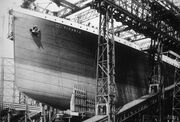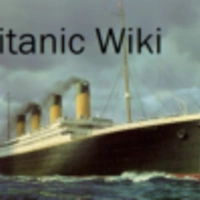
The logo of Harland and Wolff
Harland and Wolff is a company and shipyard located in Belfast, Northern Ireland, where the three ships of the Olympic-Class, (Titanic, Olympic, and Britannic) were built. The company was founded by Edward Harland and Gustav Wolff in 1861. It was known for having built all of White Star Line's ships.

Harland & Wolff building - Titanic: Honor and Glory videogame
The Olympic-class ships were built on the Arrol Gantry, which was erected in 1908 after being commissioned to build these big ships.
It temporarily ceased operations on August 5th, 2019, and entered into administration, but was saved on October 1st, 2019, when it was bought by the London-based energy firm InfraStrata.
Origin, beginning, early history[]
Harland and Wolff was formed beginning in 1861 by Edward James Harland (1831-1895) and Gustav Wilhelm Wolff (1834-1917). In 1858, Harland, then general manager, bought the small shipyard on Queen's Island, which was owned by Robert Hickson since 1853. The shipyard soon grew, building extensive facilities for engineering and architectural work (still in existence) and two large docks or construction frames, embedded in a cementitious floor. Harland made a success of the company through several innovations, in particular the replacement of the wooden upper deck by an iron one, with which the increase in the payload of the ships was achieved, incorporating the reinforced keel with lower ribs. and square section, which increased its load capacity.

Titanic's bow at Harland and Wolff
Harland & Wolff made a deal with the White Star Line shipping company partnering with the naval architect and businessman, Baron William Pirrie; In this way, H & W, thanks to its management, would build the ships of that company in exchange for not building line ships for rival companies (Cunard Line and Union Castle). Edward James Harland died in 1894 and William James Pirrie became the company's president until his sudden death in 1924. Under Pirrie's supervision, the famous Olympic-class ocean liners and several renowned warships were built. Thomas Andrews also became the general manager and head of the drawing department in 1907.
It was during this period that the company built the RMS Olympic, her famous and wrecked sister ship RMS Titanic and the HMHS Britannic between 1909 and 1914. William Pirrie was commissioned to build a massive double-framed portico and slipway for the project. These were three of more than 70 ships built for the White Star Line by the company, the last being RMS Britannic in 1929 and RMS Georgic in 1932. The shipyard's headquarters were changed in 1962, when the company chose to consolidate its operations in Belfast. The buildings are still visible today.
The World Wars[]
In the First World War, Harland and Wolff built monitors and cruisers, HMS Glorious. In 1918, the company opened a new shipyard on the eastern side of the Musgrave Channel which was named the East Yard. This yard specialised in mass-produced ships of standard design developed in the First World War.
During World War I, Harland and Wolff built monitors and cruisers, including the 15-inch gun armed "large light cruiser" HMS Gloriuos. In 1918, the company opened a new yard on the eastern side of the Musgrave Canal, which was named East Yard Shipyard. This shipyard specialized in the mass production of standard ships of design developed during the First World War. The company started an aircraft manufacturing subsidiary in 1936. Its first order was for 189 Handley Page Hereford bombers built under license from Handley Page for the Royal Air Force. The shipyard was busy during World War II, building 6 aircraft carriers, 2 cruisers (including HMS Belfast) and 131 other warships, and repairing more than 22,000 ships.
It also made tank and artillery components. It was during this period that the company's workforce peaks at around 35,000 people. However, many of the ships built during this era were commissioned at the end of World War II. Like Harland and Wolff they focused on ship repair for the first three years of the war. The Queens Island shipyard was heavily bombed by the Luftwaffe in April and May 1941 causing considerable damage to the shipbuilding facilities and the destruction of the aircraft factory. The original plans for the Titanic were lost in a fire at that fateful time.
Post-WW2[]
With the increase in the power of the jet aircraft, in the late 1950s, the demand for ships decreased.
This, along with competition from Japan, led to difficulties for the British shipping industry. The last ship the company built was the SS Canberra in 1960. In the 1960s, it carried out with notable success the tanker Myrina which was the first supertanker built in the UK, and the largest ship ever launched from a slipway (September of 1967). In the same period, the shipyard also built the Quest semi-submersible offshore drilling rig, which, due to its three-legged design, was launched in parallel three slipways. This was a first and only time that this was ever done.
In the mid-1960s, the British government began promoting loans and subsidies to British shipyards to preserve jobs. Part of this money was used to finance the modernization of the shipyard, which enabled it to build the largest merchant fleet after the war, merchant ships totaling 333,000 tons. However, it led to continuing problems for the company as part of the unionization and nationalization of the British shipyards in 1977. The company was taken over from the British government in 1989 in a management-and-employee partnership with Norwegian business magnate Fred Olsen shipping, leading to a new company called Harland and Wolff Holdings PLC.
By this time, the number of people employed by the company had dropped to one-tenth, around 3,000. For the next several years, Harland and Wolff dabbled in building standard Suezmax tankers, and has continued to focus on vessels in offshore for the oil and gas industry, which has made a few inroads outside of this market. The company unsuccessfully bid a counter-offer from Chantiers de l'Atlantique for the construction of Cunard's new line RMS Queen Mary 2. The shipyard is located mainly in the Protestant area of East Belfast, for most of In its history, the workers at Harland and Wolff were almost exclusively Protestant.
At certain times, Catholics working in the shipyard provoked religious discrimination and, at times, violent attacks and threats. While there is little concrete evidence of this (save for the Maurice O'Kane case which was filmed by the Ulster Volunteer Force), some Catholic workers insist on its accuracy. The O'Kane case, while occurring within the shipyard, was not pursued by any of O'Kane Sr.'s co-workers and, in fact, a number of workers on both sides of the division have claimed that the working class, mainly the situation of the united shipyard workers, regardless of their political and religious affiliation.
1990's-today[]
In the 1990s, the yard is part of the continuing British Aerospace team for the Royal Navy's Future Carrier (CVF) programme. The ship was planned to be built in Belfast. However in 1999 it merged with BAe Marconi Electronic Systems. The new company, BAE Systems Marine, now owns the former Marconi shipyards at Barrow and the Clyde and is likely to build the ships at one of these.
Harland and Wolff tried to change and expand their businesses, focusing less on shipbuilding and more on structural design and engineering, as well as ship repair, offshore construction projects, and other projects competing to do with the engineering and construction metal. This led to Harland and Wolff building a series of bridges in Great Britain and also in the Republic of Ireland, building on the success of their first foray into the civil engineering sector with the construction of the Foyle Bridge and others such as the restoration of the Dublin 'Penny Bridge'.
Eventually, Harland and Wolff had stopped building ships. Instead, they built engines and repair damaged ships though the company had indeed seen its ship-related workload increase slightly. Harland and Wolff's last shipbuilding project (to date) was the MV Point Anvil, 6 of a nearly identical point maritime class ships built for use by the Ministry of Defence. The vessel, built under the sub-contract of German naval firm Flensburger Schiffbau-Gesellschaft, was commissioned in 2003. Belfast's skyline is still dominated today by Harland and Wolff's two famous gantry cranes, Samson and Goliath, built in 1974 and 1969 , respectively. In late 2007, the "Goliath" of gantry cranes was returned to commission, having been bailed in 2003 due to a lack of heavy lifting work in the yard.
On August 5th 2019, the company announced they would cease trading, and entered into Administration, on August 7th, 2019. They were subsequently bought by the London-based energy firm InfraStrata, saving the remaining jobs.
